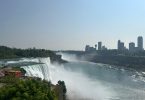I recently returned from Barbados, landing at Miami International Airport during what should have been a peak evening hour, but something was missing: people. The usually buzzing airport felt eerily quiet. Even the visitors’ immigration line — once a choke point of international arrivals — was noticeably sparse.
The scene coincides with a new travel ban rolled out under President Donald Trump’s renewed immigration enforcement push. The policy, which took effect this week, bars entry to citizens from more than a dozen predominantly African, Middle Eastern, and Caribbean nations, including Haiti, Eritrea, Sudan, and Somalia, while also placing heightened restrictions on others, such as Cuba, Venezuela, and Sierra Leone.
Although this version of the ban is more legally refined than its chaotic 2017 predecessor, its real-world effects are unmistakable. Travelers from affected countries, even those holding valid visas, are experiencing increased scrutiny, long delays, and — in some cases — denied entry. One Guatemalan couple, for instance, was subjected to three separate interviews at Miami Airport before finally being allowed to visit their son — after 22 years apart.
Even global celebrities aren’t immune. Khaby Lame, the world’s most-followed African-born TikTok star, was recently detained by Immigration and Customs Enforcement (ICE) and forced to leave the U.S. for allegedly overstaying his visa. With more than 162 million followers and partnerships with brands like Boss, Binance, and UNICEF, Lame’s story has drawn international headlines, and unearthed fresh concerns about how the U.S. treats foreign visitors.
The White House defends the policy as a national security measure, officially calling it a Presidential Action to “[r]estrict the entry of foreign nationals to protect the United States from foreign terrorists and other national security and public safety threats.”
Critics, however, say the ban fosters division under the guise of safety. “This policy is not about national security,” says Abby Maxman of Oxfam America. “It’s about sowing division and vilifying communities.”
Meanwhile, the economic cost is mounting.
According to the World Travel & Tourism Council, the U.S. is projected to lose $12.5 billion in international visitor spending this year, making it the only one of 184 countries expected to see a decline in inbound tourism in 2025.
Let that sink in: While other nations are rolling out welcome mats post-pandemic, the U.S. seems to be hanging out a “closed” sign.
- UK travel to the U.S. is down 15%.
- Germany, down 28%.
- South Korea, down 15%.
- Even Canada — the closest ally and tourism partner of the U.S. — is seeing early summer bookings fall by more than 20%.
And these aren’t just numbers. They represent empty hotels, canceled tours, quiet restaurants, and lost jobs. In 2019, international visitors brought in $217 billion and supported nearly 18 million American jobs. That legacy is now at risk — not because the world no longer wants to visit, but because the U.S. is making it harder and less appealing to do so.
The Khaby Lame incident only amplifies the message. If the U.S. can’t make room for a comedian beloved around the world, what message does that send to students, entrepreneurs, or families planning a visit?
This is more than a visa issue — it’s a perception crisis, and in global tourism, perception is currency.
Yes, domestic travel has helped the industry rebound post-COVID, but long-term growth lies in international arrivals; the very group now being discouraged, scrutinized, or shut out.
Now, as Trump-era immigration policies slam the door on entire nations and subject legitimate visitors to suspicion and harassment, no marketing campaign can mask the fallout. If America keeps signaling “you’re not welcome,” it’s only a matter of time before the world stops showing up — and the U.S. tourism industry collapses under the weight of its own exclusion.










